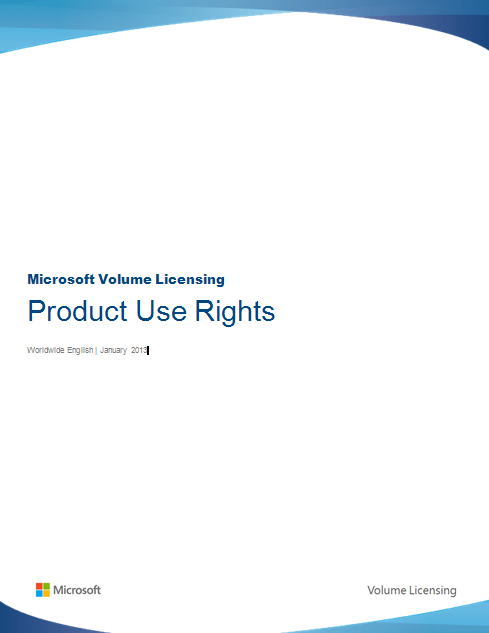How do I know which Product Use Rights to use?
By Mark Mauermann
Summary: Microsoft publishes the Product Use Rights, commonly known as the PUR, on a quarterly basis. Because the use rights and license terms change, knowing which PUR you should be using when evaluating a licensing model, contemplating a purchase or downgrade, and evaluating compliance is important. Here is a basic explanation.
Blog: When you purchase a software license through a Microsoft Volume Licensing program, the terms and conditions for how you can use that software is primarily defined in the Product Use Rights, or PUR. The Product Use Rights is an official legally binding document that you agree to follow in the license program Agreement you sign when purchasing licenses.
To learn more about the other Licensing documents, otherwise known as the “Licensing Stack,” which may affect your use of your products, please see our Licensing Stack blog post.
A common question our Licensing Team gets in one form or another is, “which PUR should I be using?” This is especially common if you have licenses for several editions of the same software, or have Software Assurance coverage which gives you rights to a new version.
Here is general guidance:
For Current and Future Versions of a Product: When you buy a license(s) for a Microsoft Products through a Volume License Program (e.g. Open Business, Open Value, Select, EA), the Product Use Rights in effect on date the agreement becomes effective, will apply. For future versions, the Product Use Rights in effect when those future versions are released, will apply.
For example, if you buy a license for SharePoint 2013 in December 2012 on a new Agreement, which starts on December 2012 – you should refer to the October 2012 PUR (which was the most current version of the PUR that was available in December 2012). Generally, PUR’s are released in the months of January, April, July and October.
Let’s continue with this example, and let’s say you buy another SharePoint 2013 Server license later the next calendar year under the same Agreement. You should still refer to the October 2012 PUR because SharePoint 2013 is still the current version of the Product, and the second license was purchased on the same Agreement that was originally started in December 2012.
Let’s continue using the same example above with SharePoint 2013 Server licenses purchased on an Agreement started in December 2012. With these licenses, let’s say you also purchased Software Assurance (SA) coverage, which aligns to the duration or term of agreement and has new version rights as one of the many benefits. If during the term of your SA coverage, a new version of SharePoint Server is released and you decide to move to the newest version of SharePoint – the PUR in effect for the new version released will apply. If you choose to the new version, you MUST use the PUR for that new version as outlined above. Also if you purchase a license for that new version, the current PUR, when that version was released will apply.*
*Please note that this does not apply to Online Services.
For Prior Versions aka Downgrades : In many cases, we understand you buy licenses, through a volume license program, for current versions of Products with the specific intent on downgrading to a prior version of that Product. When this is the case, you must use the PUR in effect on the Agreement start date for the version you licensed – not the version you will downgrade to and deploy or run.
This is a particularly common question when the license model for a Product changes significantly with the newest version. For example, if you buy SQL 2012 licenses, which have moved from the Processor to Core licensing model under a VL Agreement of some type – but deploy 2008 R2 (the server/cal model remains for some editions) instead of the SQL 2012 you purchased – you are still required to use the PUR in effect for the version licensed (e.g. 2012) as described in the section above.
As is the case with most all licensing related topics – there can always be exceptions for certain Products or Programs. These exceptions are generally called out in your Agreement Terms and Conditions or T’s and C’s, or the Product List.
The most common exceptions are for Online Services, which generally always require you to follow the most current PUR, or for Products which have a significant change in licensing model when a new version is released, which in my experience is quite rare. These exceptions will depend completely upon the Product, and decisions made by each Product Group. Such exceptions will always be called out in the Product List. When in doubt over which Product Use Rights document applies to a particular piece of software, always consult your licensing resources such as your Agreement, the PUR, Product List, or contact your reseller or account team.
The current PUR and 10+ year archive can be downloaded here.
This is one scenario and licensing situation. Each customer scenario can vary by deployment, usage, product version, and product use rights. Always check your contract, and the current Products Use Rights document to confirm how your environment should be fully licensed. The blogging team does not warrant that this scenario will be the right licensing solution for other similar cases.